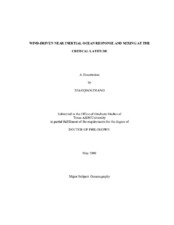| dc.contributor.advisor | DiMarco, Steven F. | |
| dc.creator | Zhang, Xiaoqian | |
| dc.date.accessioned | 2010-07-15T00:12:14Z | |
| dc.date.accessioned | 2010-07-23T21:43:46Z | |
| dc.date.available | 2010-07-15T00:12:14Z | |
| dc.date.available | 2010-07-23T21:43:46Z | |
| dc.date.created | 2009-05 | |
| dc.date.issued | 2010-07-14 | |
| dc.date.submitted | May 2009 | |
| dc.identifier.uri | https://hdl.handle.net/1969.1/ETD-TAMU-2009-05-493 | |
| dc.description.abstract | The spatial structure and temporal evolution of sea breeze and the latitudinal
distribution of propagation and mixing of sea breeze driven near-inertial ocean response
in the Gulf of Mexico are investigated using comprehensive data sets and a non-linear
numerical model. Near 30�N, inertial oceanic response is significantly enhanced by a
near-resonant condition between inertial and diurnal forcing frequencies.
Observational results indicate that sea breeze variability peaks in summer and
extends at least 300 km offshore with continuous seaward phase propagation. The
maximum near-inertial oceanic response occurs in June when there is a shallow mixed
layer, strong stratification, and an approximately 10-day period of continuous sea breeze
forcing. Near-inertial current variance decreases in July and August due to the deepening
of the mixed layer and a more variable phase relationship between the wind and current.
River discharge varies interannually and can significantly alter the oceanic response
during summer. During 1993, the ?great flood? of the Mississippi River deepens the
summer mixed layer and reduces the sea breeze response. The near-inertial currents can provide considerable vertical mixing on the shelf in summer, as seen by the suppression
of bulk Richardson number during strong near-inertial events.
Three-dimensional idealized simulations show that the coastal oceanic response to
sea breeze is trapped poleward of 30� latitude, however, it can propagate offshore as
Poincare waves equatorward of 30� latitude. Near 30� latitude, the maximum oceanic
response to sea breeze moves offshore slowly because of the near-zero group speed of
Poincare waves at this latitude. The lateral energy flux convergence plus the energy
input from the wind is maximum near the critical latitude, leading to increased vertical
mixing. This local dissipation is greatly reduced at other latitudes. Simulations with
realistic bathymetry of the Gulf of Mexico confirm that a basin-wide ocean response to
coastal sea breeze forcing is established in the form of Poincare waves. This enhanced
vertical mixing is consistent with observations on the Texas-Louisiana Shelf.
Comparison of the three-dimensional and one-dimensional models shows some
significant limitations of one-dimensional simplified models for sea breeze simulations
near the critical latitude. | en |
| dc.format.mimetype | application/pdf | |
| dc.language.iso | eng | |
| dc.subject | sea breeze | en |
| dc.subject | near-inertial motions | en |
| dc.subject | resonance | en |
| dc.subject | Poincare waves | en |
| dc.subject | mixing | en |
| dc.subject | Gulf of Mexico | en |
| dc.title | WIND-DRIVEN NEAR INERTIAL OCEAN RESPONSE AND MIXING AT THE CRITICAL LATITUDE | en |
| dc.type | Book | en |
| dc.type | Thesis | en |
| thesis.degree.department | Oceanography | en |
| thesis.degree.discipline | Oceanography | en |
| thesis.degree.grantor | Texas A&M University | en |
| thesis.degree.name | Doctor of Philosophy | en |
| thesis.degree.level | Doctoral | en |
| dc.contributor.committeeMember | Hetland, Robert D. | |
| dc.contributor.committeeMember | Smith, David C. | |
| dc.contributor.committeeMember | Jochens, Ann E. | |
| dc.contributor.committeeMember | Epifanio, Craig C. | |
| dc.type.genre | Electronic Dissertation | en |
| dc.type.material | text | en |


